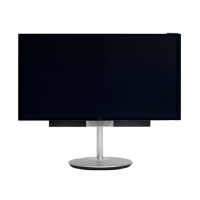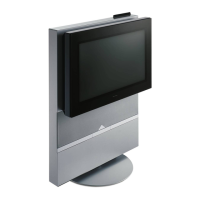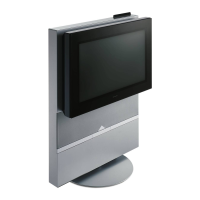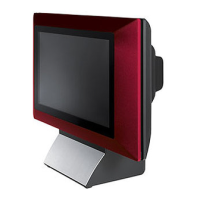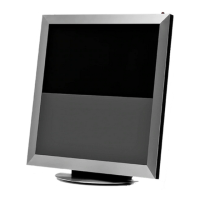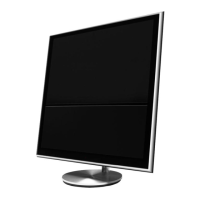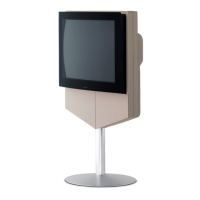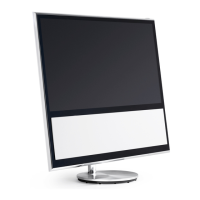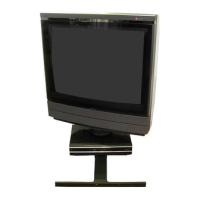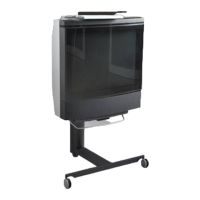
Do you have a question about the Bang & Olufsen BeoVision Avant-85 and is the answer not in the manual?
| Brand | Bang & Olufsen |
|---|---|
| Model | BeoVision Avant-85 |
| Category | TV |
| Language | English |
Details on operating the television with the BeoRemote One.
Information on using the BeoRemote App for television operation.
Information on printed and on-screen guides.
Explains how to navigate menus and make settings.
Examples of remote control operations for picture modes.
Details on navigating menus and selecting settings.
How to save and activate custom viewing and listening experiences.
Guidelines for setup by qualified personnel and ventilation.
Details on television placement options and weight considerations.
How the television should be supported and handled.
Information on available stands and wall brackets.
Identifies connection panel and other important items.
Instructions on gathering and running cables neatly.
How to clean the television screen properly.
How to clean the cabinet and controls.
How to connect extra products like Blu-ray players or music systems.
Details on permanent connections and internet connectivity.
Connection to the mains supply.
For connection of motorised stands or wall brackets.
For connection of a calibration microphone.
For connection of external speakers in surround sound.
Left and right line input.
Connects sources like set-top boxes, players, or PCs.
For connecting USB devices to browse files.
For internet connection, Smart TV, and updates.
For antenna signal connection, currently not in use.
Connects sources like set-top boxes, players, or PCs.
For connecting USB devices to browse files.
For common interface connection, currently not in use.
How to connect external HDMI sources.
Steps to connect and configure digital sources.
Steps to connect a camera to the television.
Steps to connect a computer for audio and video.
How to connect an analogue audio source like an Mp3 player.
How to use IR-transmitters for non-Bang & Olufsen products.
How to connect wired and wireless speakers.
Steps to connect wired speakers using Power Link cables.
Steps to set up products in the Source list menu.
How to register products connected via HDMI IN.
Information about downloading and using PUC tables.
How to select and configure a PUC socket for a product.
Setting and adjusting sound modes for different content.
How to select speaker groups for listening positions.
Options to switch off the picture when selecting an audio source.
How to select and set up different picture modes.
How to set up the picture format for a source.
Adjusting brightness, contrast, shift, and zoom.
Automatic source selection upon signal detection.
Setting the audio level for connected sources.
Setting screen blanking time for source startup.
Selecting source presence in remote control displays.
Resetting source settings to default.
How to turn and set automatic positions for the stand.
Setting startup, standby, and custom stand positions.
Calibrating the motorised movement of the stand.
Calibration steps for motorised floor stands.
Calibration steps for motorised wall brackets.
Tilting the television on a table stand.
Activating transport mode and recalibrating the stand.
Watching analogue and digital channels, and using programme info.
Steps to select a desired source for viewing.
How to turn or tilt the television mounted on stands or brackets.
Using sound modes and speaker groups for surround sound.
Choosing and setting up sound modes for optimal listening.
Selecting speaker groups for different listening positions.
Precautions and warnings for 3D viewing.
Recommended conditions for optimal 3D viewing experience.
How to switch between 3D and 2D viewing modes.
Using the PUC interpreter for remote operation of products.
How to access and use apps on the television.
Steps to select and open an app from the Apps shelf.
How to install apps from the App Gallery or Google Play Store.
How to lock apps unsuited for children.
Using a USB hard drive to extend TV memory for apps.
Agreeing to terms of use for apps and services.
Accessing music and video streaming services.
How to play downloaded and installed games.
Browsing the internet on the television.
How to launch and use the internet browser.
Using voice commands and search functions.
Pairing and using Bluetooth headphones.
Playing music and video files from storage or media servers.
Viewing photos or playing media from a USB drive.
Playing media from a computer or NAS via home network.
Viewing photos or playing media from cloud services.
Opening and playing music files from connected devices.
Opening and viewing photo files, starting slide shows.
Opening and playing video files from connected devices.
Using smartphones and tablets with the television.
Casting apps from devices to the TV screen.
Adding AirPlay functionality for Android televisions.
Connecting MHL compliant mobile devices for display and charging.
Adjusting picture settings like contrast, brightness, and colour.
Selecting and setting up different picture modes.
Adjusting backlight intensity of the TV screen.
Adjusting contrast for better picture definition.
Adjusting picture sharpness for clarity.
Reducing noise in the picture.
Adjusting balance between bright and dark areas of the picture.
Setting preferences for automatic 3D mode activation.
Setting preferred movie judder cancellation behaviour.
Adapting picture based on surrounding light conditions.
Entering viewing distance for optimal settings.
Viewing signal information about the received video signal.
Resetting all picture settings to default.
Setting up surround sound systems with BeoLab speakers.
Setting up optimized sound modes for different content.
Managing low frequencies, crossover, panning, and redirection.
Adjusting bass and treble balance.
Adjusting low and high frequency bands.
Improving intelligibility of dialogue.
Redirecting input signals to different speaker channels.
Modifying audio signal based on listening activity.
Using Low Frequency Effects channel for sound effects.
Increasing low/high frequencies as volume decreases.
Adjusting perceived sound aspects like surround and stage width.
Reducing difference between quietest and loudest moments.
Resetting sound settings for selected sound mode.
Making speaker groups for different listening positions.
Steps to create or edit a speaker group.
Assigning functions to loudspeakers in a surround system.
Entering distance between listening position and each speaker.
Adjusting sound level from connected speakers.
Automatic calibration using a microphone.
Managing low frequencies, crossover, panning, and redirection.
Directing LFE signal to a ceiling speaker.
Adjusting subwoofer delays and all-pass frequency.
Setting the initial and maximum volume levels.
Adjusting bass and treble levels.
Compensating for reduced bass/treble perception at low volumes.
Looking up current sound system information.
Power saving settings for sound, switching off idle speakers.
Setting up wired and wireless speakers.
Removing a wireless speaker association.
Connecting wired and wireless speakers.
Connecting and setting up a USB hard drive for apps.
Connecting and setting up a USB keyboard.
Introduction to activating and using the pin code system.
Activating or deactivating the pin code system.
Changing the existing pin code.
Setting the television to switch off automatically.
Resetting picture and sound settings to default.
Reinstalling the television and going through first-time setup.
Setting language, time, and date preferences.
Selecting menu, audio, and subtitle languages.
Setting the clock mode, time zone, date, and time.
Configuring automatic or manual time and daylight saving.
Selecting the local time zone.
Setting the television to switch off after a period.
Overview of describing audible/visual elements via sound/subtitles.
Activating or deactivating accessibility features.
Enabling special audio and subtitles for the hearing impaired.
Enabling audio commentary for the visually impaired.
Selecting a network connection type.
Steps to connect the television to a network.
Steps for establishing a wired network connection.
Steps for establishing a wireless network connection.
Connecting directly to a router using WPS.
Connecting via WPS using a PIN code.
Viewing information about the network connection.
Setting up network configuration (DHCP or Static IP).
Manually setting up network configuration.
Enabling Wake on WLAN for remote power-on.
Enabling/disabling the Digital Media Renderer feature.
Enabling or disabling wireless network connection.
Naming the television for network recognition.
Clearing saved internet information.
Connecting Bluetooth devices by pairing.
Connecting Bang & Olufsen products via Network Link.
Integrating external products for audio and video playback.
Setting up distribution of sound from video sources.
Connecting multiple sources and televisions using HDMI Matrix.
Looking up current software version and release notes.
Downloading and installing software updates.
Enabling automatic software updates for the entire system.
Downloading and managing PUC tables for product control.
Downloading PUC tables online or from a USB device.
Updating or deleting existing PUC tables.
